A Thorough Emission-Cost Analysis of the Gradual Replacement of Carbon-Rich Fuels with Carbon-Free Energy Carriers in Modern Power Plants: The Case of Cyprus
Abstract
:1. Introduction
2. Thermal-to-Power Generation Technologies
2.1. Steam Units
- Boiler: where the combustion takes place by heating the water until it evaporates
- Turbine: which is set in motion by the release of steam which is then liquefied
- Condenser: which directs the hot water to the boiler for reheating and evaporation
- Cooling tower: where the water liquefaction is realized based on the temperature difference (otherwise the system must be cooled via pumped water from a river or the open sea)
- Pump: to redirect the liquefied water back to the boiler
2.2. Gas Units
- Burner: where combustion takes place and the exhaust gases are led to the turbine
- Turbine: which is set in motion by the release of exhaust gases which are then released into the atmosphere
2.3. Combined-Cycle Units
- Gas turbine: after being released by moving the gas turbine, the exhaust gases pass through a heat exchanger and are then released into the atmosphere
- Steam turbine: the heat recovery from the exchanger evaporates the passing water and the vapors are released giving movement to the steam turbine
2.4. Internal Combustion Engines (ICE)
3. Fuel Diversity and Combustion Pollutants
3.1. Cost Function Formulation
- system power balance: the total power produced by generating units must satisfy the total electricity demand (PD)
- spinning reserve margins (SR): the maximum capacity (Pmax_cap) of the synchronized (on-line) generators must account for forecast errors with respect to load and renewable contribution as well as for a probable generation failure
- capacity limits: each generator must operate within its minimum (Pmin) and maximum (Pmax) boundaries
- minimum up (MU) and down (MD) times: each generator can change its status once the minimum required time elapsed
- maximum ramp up (RU) and down (RD) capability: each generator possesses a maximum positive and negative rate of change of its power output
- conditional restrictions: due to environmental and economic issues some units may fall in the must-run, must-out and run at fixed-MW output
3.2. Emission Function Formulation
4. Transition to Carbon-Neutral and Carbon-Free Energy
5. Conclusions
Author Contributions
Funding
Institutional Review Board Statement
Informed Consent Statement
Data Availability Statement
Conflicts of Interest
References
- Cosi, B.; Kraja, G. A 100% renewable energy system in the year 2050: The case of Macedonia. Energy 2012, 48, 80–87. [Google Scholar] [CrossRef]
- Vad, B.; Lund, H.; Karlsson, K. 100% Renewable energy systems, climate mitigation and economic growth. Appl. Energy 2015, 88, 488–501. [Google Scholar] [CrossRef]
- Ã, R.K.; Buddhi, D.; Sawhney, R.L. Comparison of environmental and economic aspects of various hydrogen production methods. Renew. Sustain. Energy Rev. 2008, 12, 553–563. [Google Scholar] [CrossRef]
- International Energy Agency (IEA). Annual Growth for Renewable Electricity Generation; International Energy Agency: Paris, France, 2020. [Google Scholar]
- Nikolaidis, P.; Fotiou, S.; Kasparis, T.; Poullikkas, A. Dynamic analysis of high-response storage systems to minimize the generation ramping requirements. IET Conf. Publ. 2020, 2020, 398–403. [Google Scholar] [CrossRef]
- Poullikkas, A. A comparative overview of large-scale battery systems for electricity storage. Renew. Sustain. Energy Rev. 2013, 27, 778–788. [Google Scholar] [CrossRef]
- Nikolaidis, P. Mathematical and Bayesian Inference Strategies for Optimal Unit Commitment in Modern Power Systems Pavlos Nikolaidis. Ph.D. Thesis, Cyprus University of Technology, Limassol, Cyprus, 2019. [Google Scholar]
- Lund, H. Renewable energy strategies for sustainable development. Energy 2007, 32, 912–919. [Google Scholar] [CrossRef]
- Lior, N. Thoughts about future power generation systems and the role of exergy analysis in their development. Energy Convers. Manag. 2002, 43, 1187–1198. [Google Scholar] [CrossRef]
- Blok, K. Enhanced policies for the improvement of electricity efficiencies. Energy Policy 2020, 33, 1635–1641. [Google Scholar] [CrossRef]
- Hooghe, L. The European Commission and the Integration of Europe; Cambridge University Press: Cambridge, UK, 2001; pp. 1–26. [Google Scholar]
- Spanias, C.A.; Nikolaidis, P.N.; Lestas, I. Techno-Economic Analysis of the Potential Conversion of the Outdated Moni Power Plant to a Large Scale Research Facility. In Proceedings of the 5th International Conference on Renewable Energy Sources & Energy Efficiency, Nicosia, Cyprus, 5–6 May 2016; pp. 208–220. [Google Scholar]
- Poullikkas, A. Technology Prospects of Wave Power Systems. Electron. J. Energy Environ. 2014, 2, 47–69. [Google Scholar] [CrossRef]
- Bayer, P.; Aklin, M. The European Union Emissions Trading System reduced CO2 emissions despite low prices. Proc. Natl. Acad. Sci. USA 2020, 117, 8804–8812. [Google Scholar] [CrossRef] [Green Version]
- Dey, B.; Bhattacharyya, B.; Raj, S.; Babu, R. Economic emission dispatch on unit commitment-based microgrid system considering wind and load uncertainty using hybrid MGWOSCACSA. J. Electr. Syst. Inf. Technol. 2020, 7, 15. [Google Scholar] [CrossRef]
- Rezaee Jordehi, A. A mixed binary-continuous particle swarm optimisation algorithm for unit commitment in microgrids considering uncertainties and emissions. Int. Trans. Electr. Energy Syst. 2020, 30, e12581. [Google Scholar] [CrossRef]
- Yang, Z.; Guo, Y.; Niu, Q.; Ma, H.; Zhou, Y.; Zhang, L. A Novel Binary Jaya Optimization for Economic/Emission Unit Commitment. In Proceedings of the 2018 IEEE Congress on Evolutionary Computation, CEC 2018-Proceedings, Rio de Janeiro, Brazil, 8–13 July 2018; pp. 1–6. [Google Scholar]
- Nikzad, H.R.; Abdi, H. A robust unit commitment based on GA-PL strategy by applying TOAT and considering emission costs and energy storage systems. Electr. Power Syst. Res. 2020, 180, 106154. [Google Scholar] [CrossRef]
- Soltani, Z.; Ghaljehei, M.; Gharehpetian, G.B.; Aalami, H.A. Integration of smart grid technologies in stochastic multi-objective unit commitment: An economic emission analysis. Int. J. Electr. Power Energy Syst. 2018, 100, 565–590. [Google Scholar] [CrossRef]
- Catalão, J.P.S.; Mariano, S.J.P.S.; Mendes, V.M.F.; Ferreira, L.A.F.M. A practical approach for profit-based unit commitment with emission limitations. Int. J. Electr. Power Energy Syst. 2010, 32, 218–224. [Google Scholar] [CrossRef]
- Saranya, S.; Saravanan, B. Effect of emission in SMES based unit commitment using modified Henry gas solubility optimization. J. Energy Storage 2020, 29, 101380. [Google Scholar] [CrossRef]
- Gillingham, K.; Stock, J.H. The cost of reducing greenhouse gas emissions. J. Econ. Perspect. 2018, 32, 53–72. [Google Scholar] [CrossRef]
- Poullikkas, A. Introduction to Power Generation Technologies; Nova Science: Hauppauge, NY, USA, 2009; ISBN 9781119130536. [Google Scholar]
- Cengel, Y.A.; Boles, M.A.; Kanoğlu, M. Chapter 10 Vapor and Combined Power Cycles. In Thermodynamics: An Engineering Approach; The British University of Egypt: Cairo, Egypt, 2011; pp. 1–29. [Google Scholar]
- Water Environment Federation Residuals and Biosolids Committee. Internal Combustion Engines; Water Environmental Federation: Alexandria, VA, USA, 2017; pp. 1–24. [Google Scholar]
- Van Blarigan, P.; Laboratories, S.N. Advanced Internal Combustion; Warsaw University of Technology: Warsaw, Poland, 2001; pp. 1–20. [Google Scholar]
- Al Moussawi, H.; Fardoun, F.; Louahlia, H. Selection based on differences between cogeneration and trigeneration in various prime mover technologies. Renew. Sustain. Energy Rev. 2017, 74, 491–511. [Google Scholar] [CrossRef]
- Nikolaidis, P.; Poullikkas, A. Secondary battery technologies: A static potential for power. In Energy Generation and Efficiency Technologies for Green Residential Buildings; The Institution of Engineering and Technology: London, UK, 2019; pp. 191–207. [Google Scholar]
- Nikolaidis, P.; Poullikkas, A. Cost metrics of electrical energy storage technologies in potential power system operations. Sustain. Energy Technol. Assess. 2018, 25, 43–59. [Google Scholar] [CrossRef]
- Nikolaidis, P.; Poullikkas, A. A comparative review of electrical energy storage systems for better sustainability. J. Power Technol. 2011, 97, 220–245. [Google Scholar]
- Nikolaidis, P.; Chatzis, S.; Poullikkas, A. Life cycle cost analysis of electricity storage facilities in flexible power systems. Int. J. Sustain. Energy 2019, 38, 752–772. [Google Scholar] [CrossRef]
- Nikolaidis, P.; Poullikkas, A. Sustainable services to enhance flexibility in the upcoming smart grids. In Sustaining Resources for Tomorrow; Springer: Cham, Switzerland, 2020; pp. 245–274. [Google Scholar]
- Nikolaidis, P. Sustainable Routes for Renewable Energy Carriers in Modern Energy Systems. In Bioenergy Research: Commercial Opportunities & Challenges; Springer: Singapore, 2021; pp. 239–265. ISBN 978-981-16-1189-6. [Google Scholar]
- Nikolaidis, P.; Poullikkas, A. A comparative overview of hydrogen production processes. Renew. Sustain. Energy Rev. 2017, 67, 597–611. [Google Scholar] [CrossRef]
- Asada, Y.; Tokumoto, M.; Aihara, Y.; Oku, M.; Ishimi, K. Hydrogen production by co-cultures of Lactobacillus and a photosynthetic bacterium, Rhodobacter sphaeroides RV. Int. J. Hydrogen Energy 2006, 31, 1509–1513. [Google Scholar] [CrossRef]
- Hadjipaschalis, I.; Poullikkas, A.; Efthimiou, V. Overview of current and future energy storage technologies for electric power applications. Renew. Sustain. Energy Rev. 2009, 13, 1513–1522. [Google Scholar] [CrossRef]
- Simmons, T. CO2 Emissions from Stationary Combustion of Fossil Fuels. In Good Practice Guidance and Uncertainty Management in National Greenhouse Gas Inventories; IPCC: London, UK, 2000; pp. 15–40. [Google Scholar]
- Nikolaidis, P.; Chatzis, S. Gaussian process-based Bayesian optimization for data-driven unit commitment. Int. J. Electr. Power Energy Syst. 2021, 130, 106930. [Google Scholar] [CrossRef]
- Nikolaidis, P.; Chatzis, S.; Poullikkas, A. Optimal planning of electricity storage to minimize operating reserve requirements in an isolated island grid. Energy Syst. 2020, 11, 1157–1174. [Google Scholar] [CrossRef]
- Nikolaidis, P.; Partaourides, H. A Model Predictive Control for the Dynamical Forecast of Operating Reserves in Frequency Regulation Services. Forecasting 2021, 3, 228–241. [Google Scholar]
- Nikolaidis, P.; Poullikkas, A. Enhanced Lagrange relaxation for the optimal unit commitment of identical generating units. IET Gener. Transm. Distrib. 2020, 14, 3920–3928. [Google Scholar] [CrossRef]
- Nikolaidis, P.; Poullikkas, A. Co-optimization of active power curtailment, load shedding and spinning reserve deficits through hybrid approach: Comparison of electrochemical storage technologies. IET Renew. Power Gener. 2022, 16, 92–104. [Google Scholar] [CrossRef]
- Fritt-Rasmussen, J.; Wegeberg, S.; Gustavson, K.; Sørheim, K.R.; Daling, P.S.; Jørgensen, K.; Tonteri, O.; Holst-Andersen, J.P. Heavy Fuel Oil (HFO): A Review of Fate and Behaviour of HFO Spills in Cold Seawater, Including Biodegradation, Environmental Effects and Oil Spill Response; Nordisk Ministerråd: Copenhagen, Denmark, 2018; ISBN 9789289358507. [Google Scholar]
- The American Petroleum Institute. Heavy fuel oils category submitted to the US EPA. Fuel 2007, 2012, 1–138. [Google Scholar]
- Nikolaidis, P.; Poullikkas, A. A novel cluster-based spinning reserve dynamic model for wind and PV power reinforcement. Energy 2021, 234, 121270. [Google Scholar] [CrossRef]
- Nikolaidis, P.; Chatzis, S.; Poullikkas, A. Renewable energy integration through optimal unit commitment and electricity storage in weak power networks. Int. J. Sustain. Energy 2018, 38, 398–414. [Google Scholar] [CrossRef]
- Cyprus Energy Regulatory Authority. Annual Report of the Cyprus Energy Regulatory Authority; Cyprus Energy Regulatory Authority: Nicosia, Cyprus, 2020. [Google Scholar]
- Naxakis, I.; Nikolaidis, P.; Pyrgioti, E. Performance of an installed lightning protection system in a photovoltaic park. In Proceedings of the 2016 IEEE International Conference on High Voltage Engineering and Application (ICHVE), Chengdu, China, 19–22 September 2016; pp. 2–5. [Google Scholar]
- Ercan, F.; Yenen, M.; Fahrioğlu, M. Method and Case Study for Wind Power Assessment in Cyprus. In Proceedings of the Renewable Energy Sources Symposium, Nicosia, Cyprus, 19–23 September 2013; pp. 1–6. [Google Scholar] [CrossRef]
- Hadjipetrou, S.; Liodakis, S.; Sykioti, A.; Katikas, L.; Park, N.W.; Kalogirou, S.; Akylas, E.; Kyriakidis, P. Evaluating the suitability of Sentinel-1 SAR data for offshore wind resource assessment around Cyprus. Renew. Energy 2022, 182, 1228–1239. [Google Scholar] [CrossRef]
- Gallo, C. Bioclimatic Architecture; Pantheon Cultural Association Location: Nicosia, Cyprus, 1994; Volume 5, ISBN 9789963978984. [Google Scholar]
- Electricity Authority of Cyprus Annual Report of the Electricity Authority of Cyprus. 2020. Available online: https://www.eac.com.cy/EN/EAC/FinancialInformation/Pages/AnnualReports.aspx (accessed on 15 May 2022).


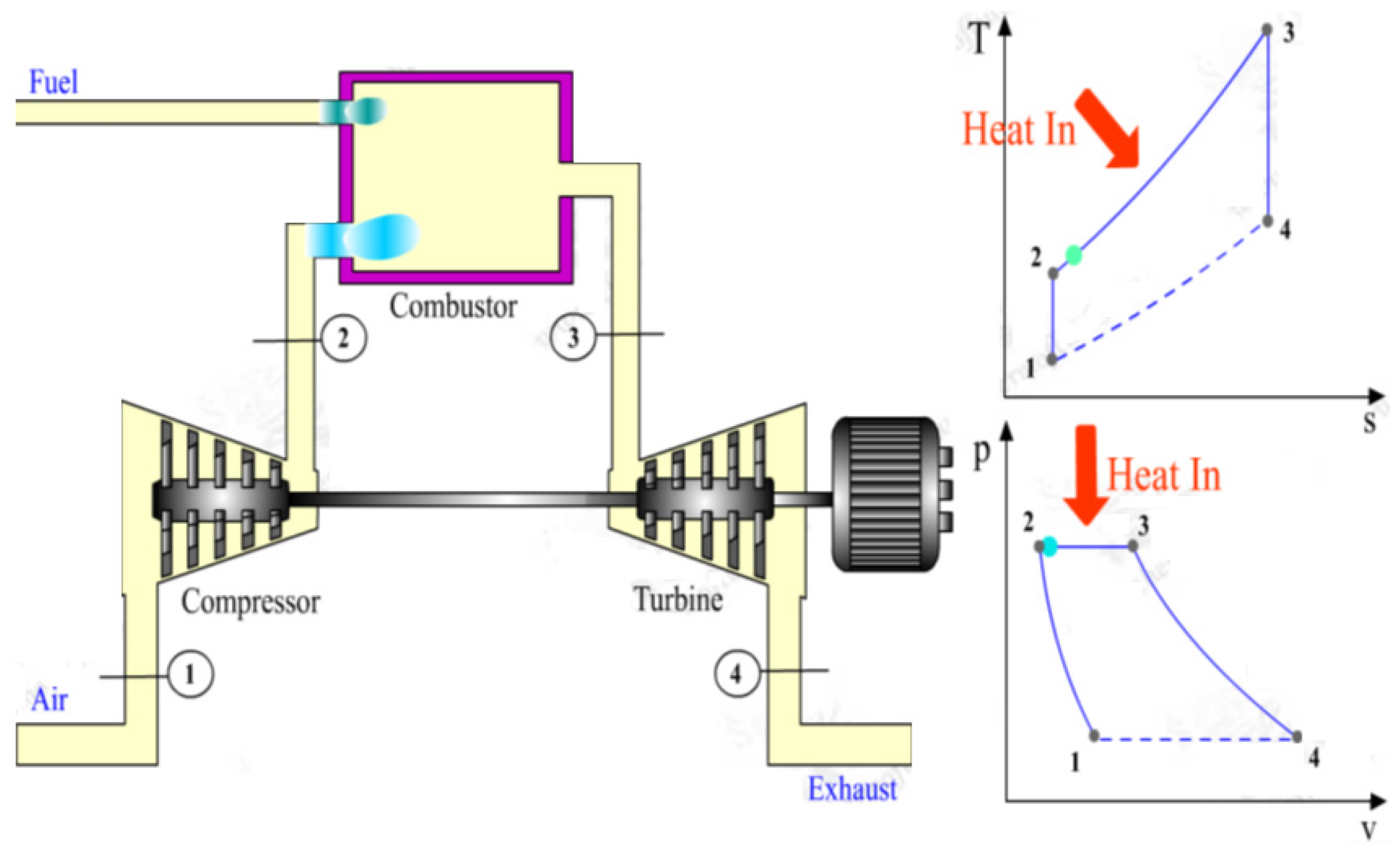


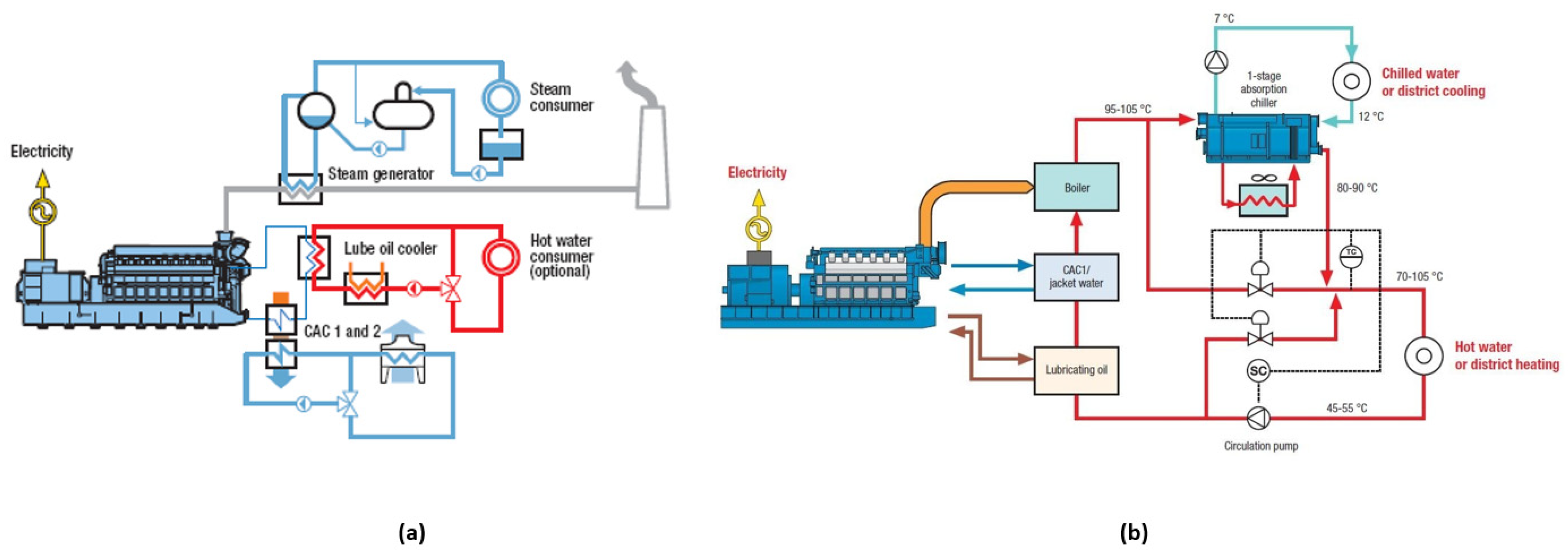
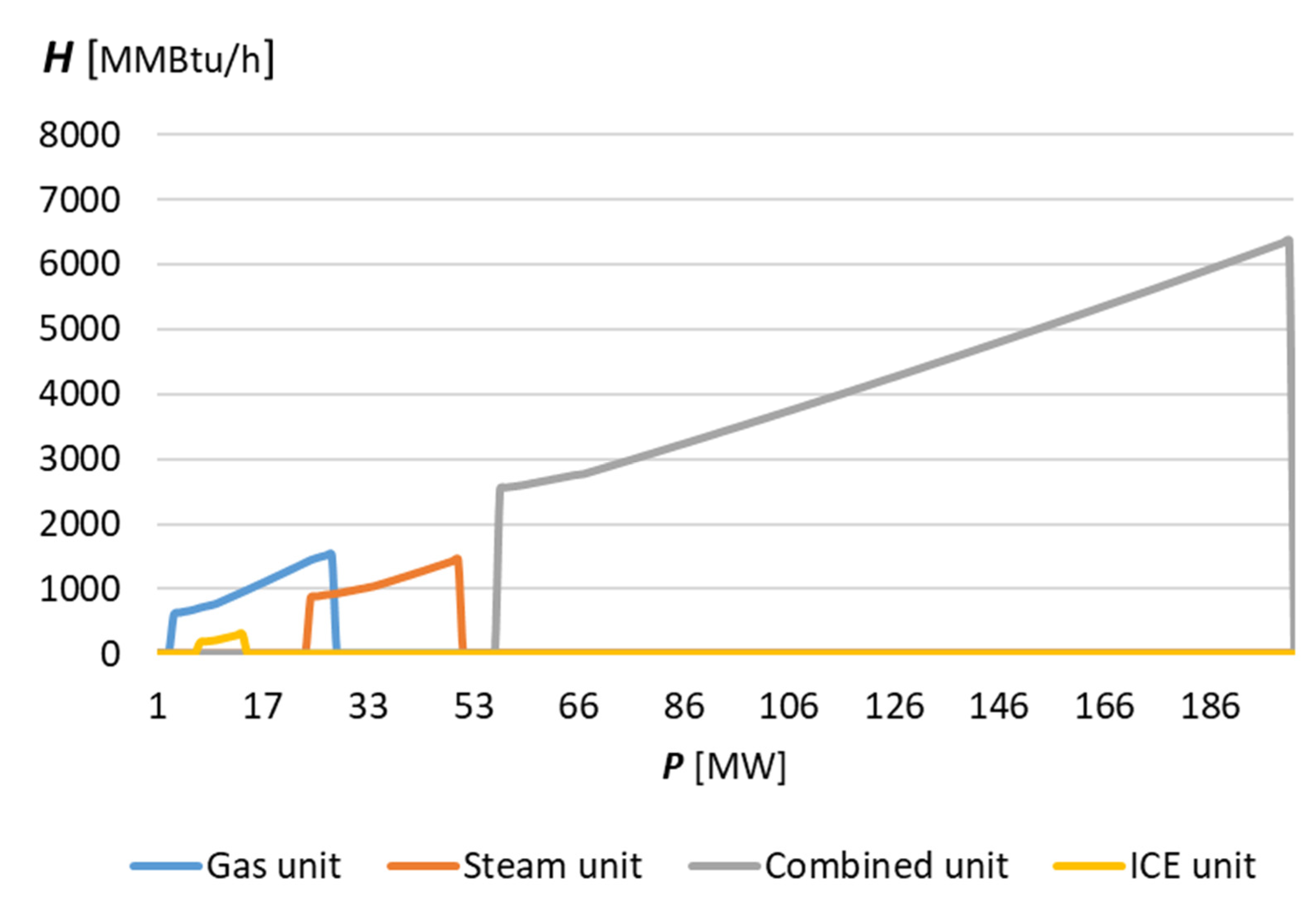
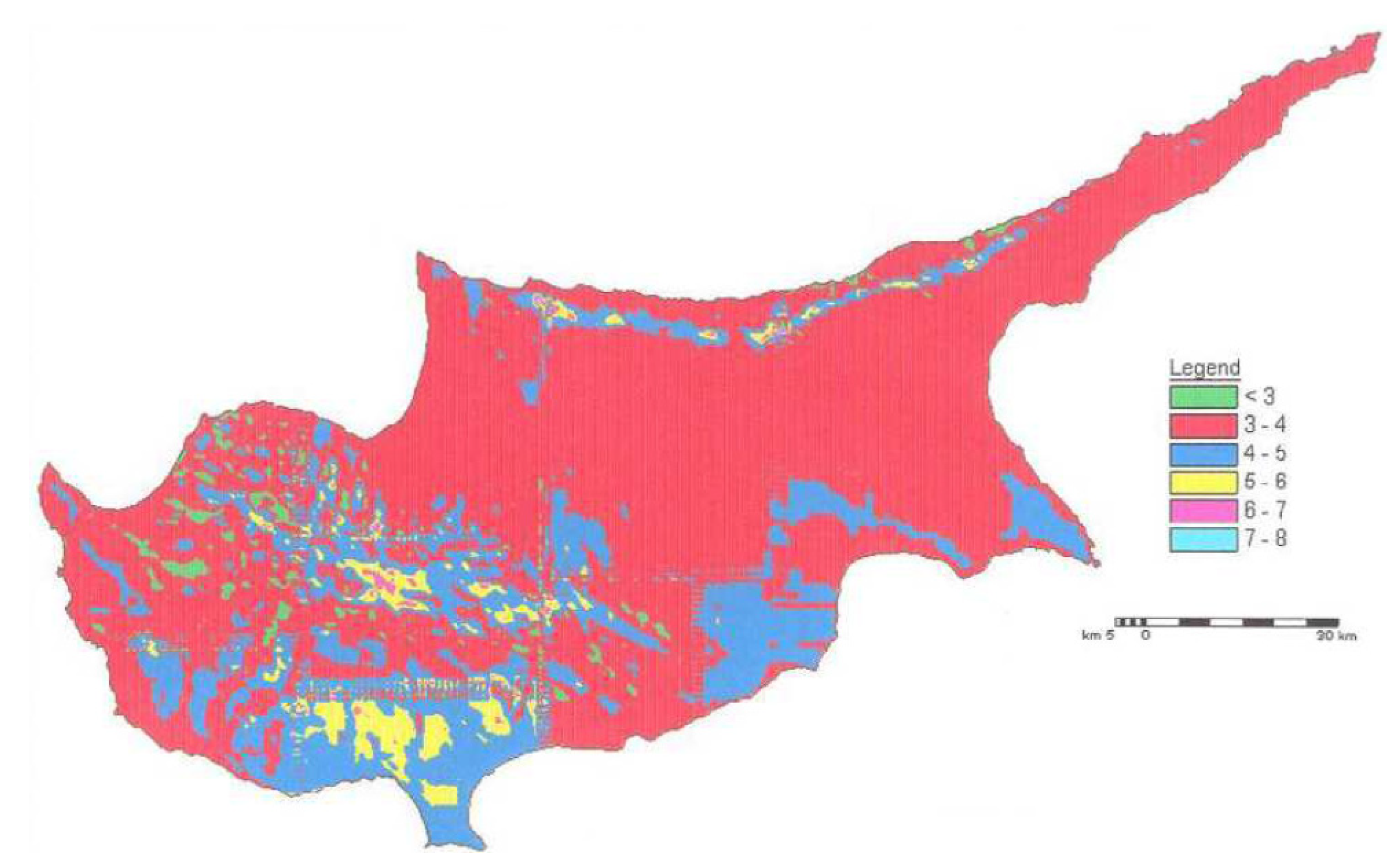




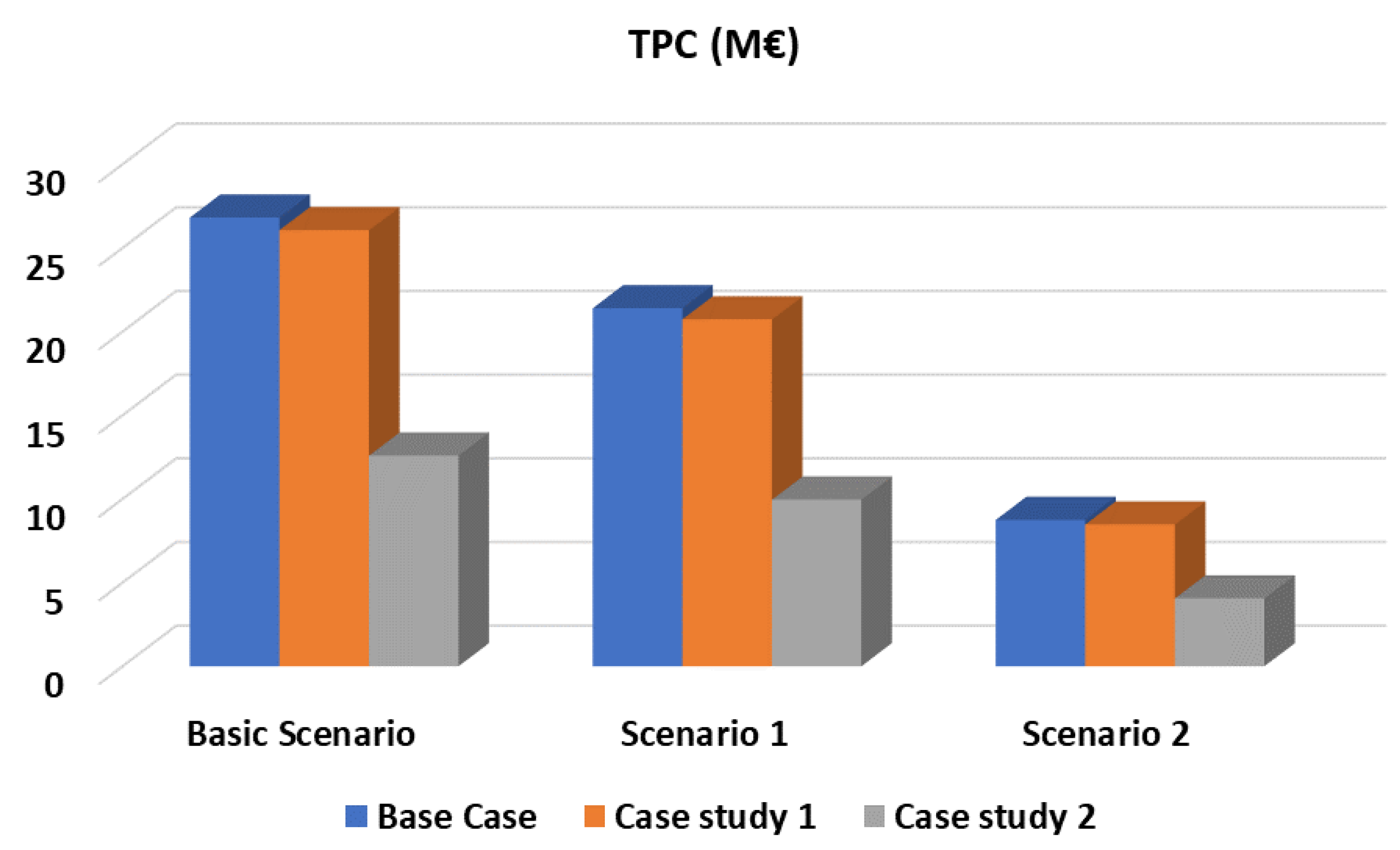
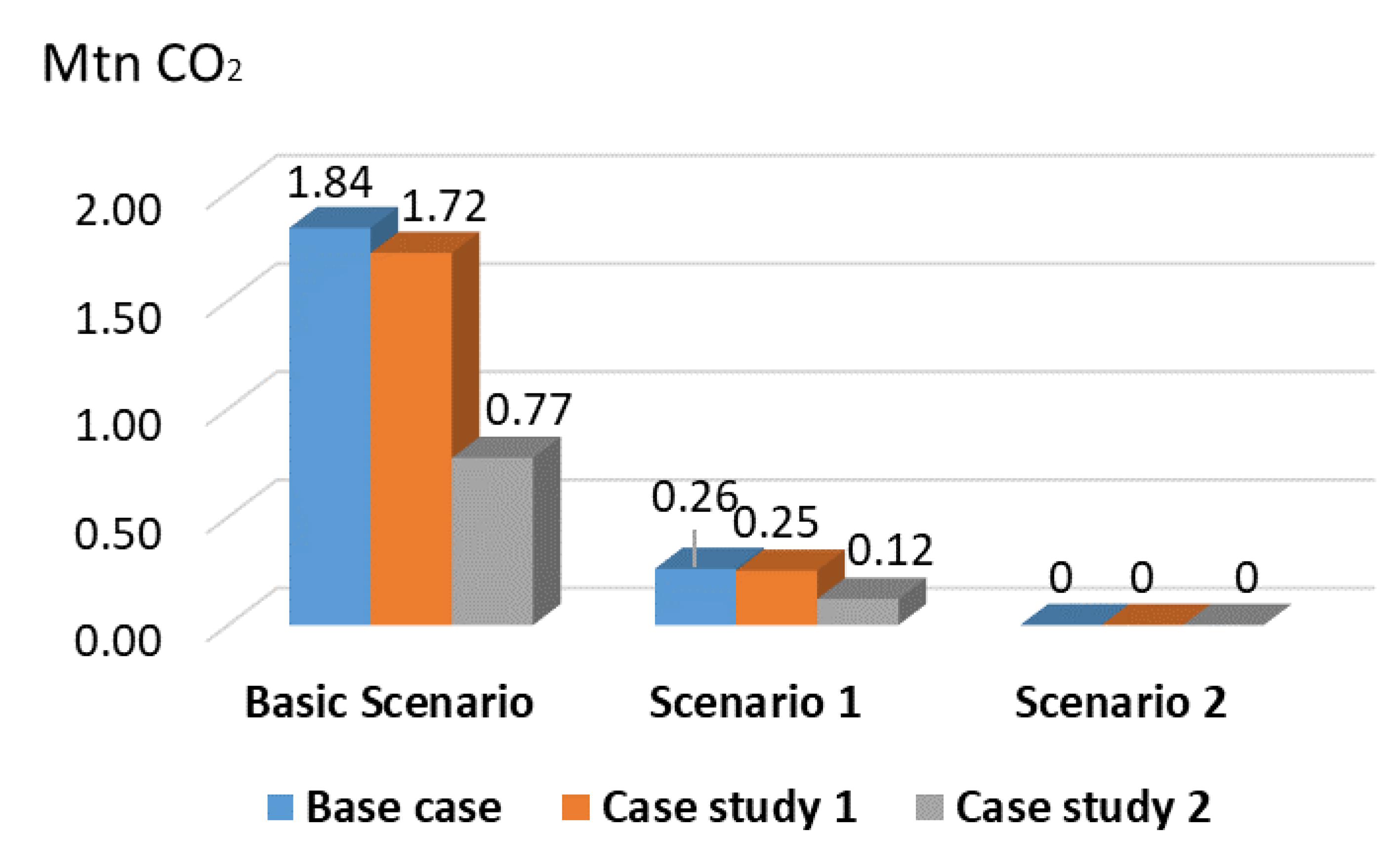

| f | NVC | EF | S | F | Cr (kgC/kgf) |
|---|---|---|---|---|---|
| HFO | 39 | 21.1 | 0.8 | 0.98 | 0.591389 |
| Diesel | 45.5 | 20.2 | 0.5 | 0.99 | 1.668167 |
| NG | 50 | 17.2 | 0.33 | 0.995 | 2.10217 |
| H2 | 120 | 0 | 0 | 0 | 0 |
| Unit | a (MBtu/MW2h) | b (MBtu/MWh) | c (MBtu/h) | Technology | Fuel | Specific Cost (€/MBtu) |
|---|---|---|---|---|---|---|
| 1–4 | 0.013 | 4.077 | 57.034 | Gas turbine | Diesel | 8.32 |
| 5–10 | 0.017 | 3.734 | 60.261 | Steam turbine | HFO | 5.05 |
| 11–13 | 0.001 | 3.741 | 9.3 | ICE | HFO | 5.05 |
| 14–16 | 0.026 | 3.105 | 11.28 | ICE | HFO | 5.05 |
| 17–18 | 0.004 | 3.407 | 74.284 | Steam turbine | HFO | 5.05 |
| 19–20 | 0.002 | 2.596 | 148.844 | Combined cycle | Diesel | 8.32 |
| Generator | Base Case | Case Study 1 | Case Study 2 |
|---|---|---|---|
| 1 | 3.154228 | 1.997647 | 0.809017 |
| 2 | 1.097265 | 0.554599 | 0.257415 |
| 3 | 0.076241 | 0 | 0 |
| 4 | 0 | 0 | 0 |
| 5 | 1678.562 | 1687.955 | 1701.377 |
| 6 | 1675.507 | 1681.205 | 1684.223 |
| 7 | 1653.869 | 1644.427 | 1628.991 |
| 8 | 1527.925 | 1502.54 | 1439.053 |
| 9 | 1253.089 | 1202.252 | 1095.075 |
| 10 | 988.9184 | 940.3106 | 826.6504 |
| 11 | 553.6949 | 561.1234 | 548.1765 |
| 12 | 553.6949 | 561.1234 | 548.1765 |
| 13 | 553.6949 | 561.1234 | 548.1765 |
| 14 | 591.9923 | 594.3116 | 587.3696 |
| 15 | 591.9923 | 594.3116 | 587.3696 |
| 16 | 591.9923 | 594.3116 | 587.3696 |
| 17 | 3459.706 | 3441.907 | 3349.22 |
| 18 | 3459.706 | 3441.907 | 3349.22 |
| 19 | 3245.911 | 2824.913 | 2272.047 |
| 20 | 852.4629 | 720.0493 | 483.3979 |
| Unit | a (MBtu/MW2h) | b (MBtu/MWh) | c (MBtu/h) | Technology | Fuel | Specific Cost (€/MBtu) |
|---|---|---|---|---|---|---|
| 1–4 | 0.012 | 3.71 | 51.901 | Gas turbine | NG | 2.60 |
| 5–10 | 0.013 | 2.912 | 47.004 | Steam turbine | NG | 2.60 |
| 11–13 | 0.001 | 2.918 | 7.254 | ICE | NG | 2.47 |
| 14–16 | 0.021 | 2.422 | 8.798 | ICE | NG | 2.47 |
| 17–18 | 0.003 | 2.658 | 57.941 | Steam turbine | NG | 2.47 |
| 19–20 | 0.002 | 2.362 | 135.448 | Combined cycle | NG | 2.47 |
| Unit | a (MBtu/MW2h) | b (MBtu/MWh) | c (MBtu/h) | Technology | Fuel | Specific Cost (€/MBtu) |
|---|---|---|---|---|---|---|
| 1–4 | 0.005 | 1.546 | 21.626 | Gas turbine | H2 | 12.52 |
| 5–10 | 0.006 | 1.214 | 19.585 | Steam turbine | H2 | 12.52 |
| 11–13 | 0.0004 | 1.216 | 3.022 | ICE | H2 | 12.52 |
| 14–16 | 0.009 | 1.009 | 3.666 | ICE | H2 | 12.52 |
| 17–18 | 0.0013 | 1.107 | 24.142 | Steam turbine | H2 | 12.52 |
| 19–20 | 0.0009 | 0.984 | 56.437 | Combined cycle | H2 | 12.52 |
| H2 Route | Process | Energy Source | Production Cost (€/MBtu) |
|---|---|---|---|
| R1 | Biomass pyrolysis | biomass | 23.59 |
| R2 | Biomass gasification | biomass | 26.12 |
| R3 | Bio-photolysis | solar | 25.51 |
| R4 | Fermentation | solar | 29.40 |
| R5 | PV electrolysis | solar | 180.94 |
| R6 | Solar-thermal electrolysis | solar | 97.11 |
| R7 | Wind electrolysis | wind | 78.92 |
| R8 | Solar thermolysis | solar | 102.03 |
| R9 | Photo-electrolysis | solar | 112.81 |
Publisher’s Note: MDPI stays neutral with regard to jurisdictional claims in published maps and institutional affiliations. |
© 2022 by the authors. Licensee MDPI, Basel, Switzerland. This article is an open access article distributed under the terms and conditions of the Creative Commons Attribution (CC BY) license (https://creativecommons.org/licenses/by/4.0/).
Share and Cite
Nikolaidis, P.; Poullikkas, A. A Thorough Emission-Cost Analysis of the Gradual Replacement of Carbon-Rich Fuels with Carbon-Free Energy Carriers in Modern Power Plants: The Case of Cyprus. Sustainability 2022, 14, 10800. https://doi.org/10.3390/su141710800
Nikolaidis P, Poullikkas A. A Thorough Emission-Cost Analysis of the Gradual Replacement of Carbon-Rich Fuels with Carbon-Free Energy Carriers in Modern Power Plants: The Case of Cyprus. Sustainability. 2022; 14(17):10800. https://doi.org/10.3390/su141710800
Chicago/Turabian StyleNikolaidis, Pavlos, and Andreas Poullikkas. 2022. "A Thorough Emission-Cost Analysis of the Gradual Replacement of Carbon-Rich Fuels with Carbon-Free Energy Carriers in Modern Power Plants: The Case of Cyprus" Sustainability 14, no. 17: 10800. https://doi.org/10.3390/su141710800
APA StyleNikolaidis, P., & Poullikkas, A. (2022). A Thorough Emission-Cost Analysis of the Gradual Replacement of Carbon-Rich Fuels with Carbon-Free Energy Carriers in Modern Power Plants: The Case of Cyprus. Sustainability, 14(17), 10800. https://doi.org/10.3390/su141710800









